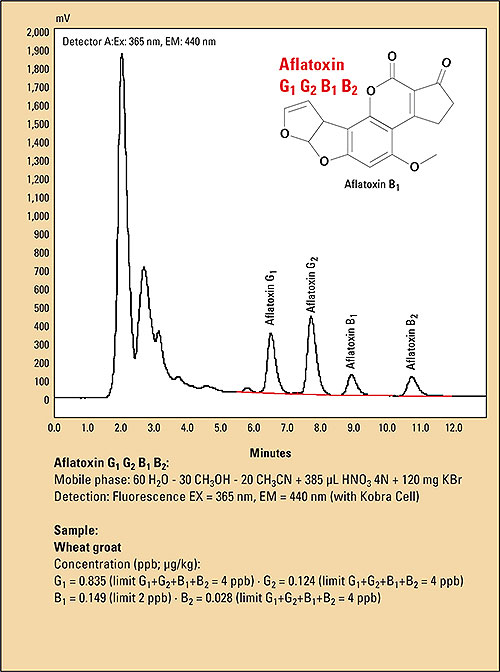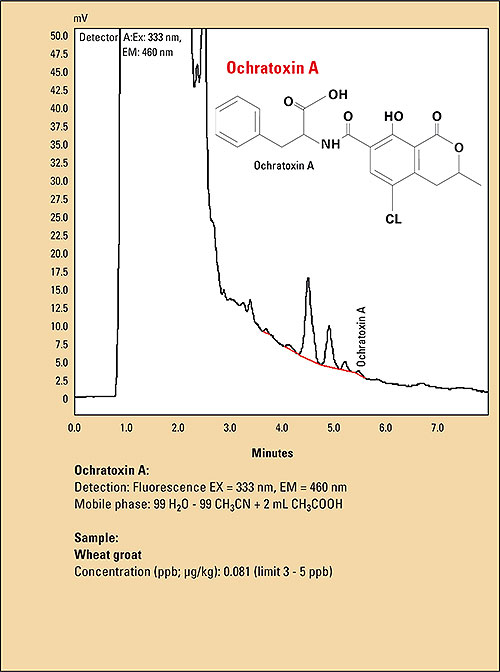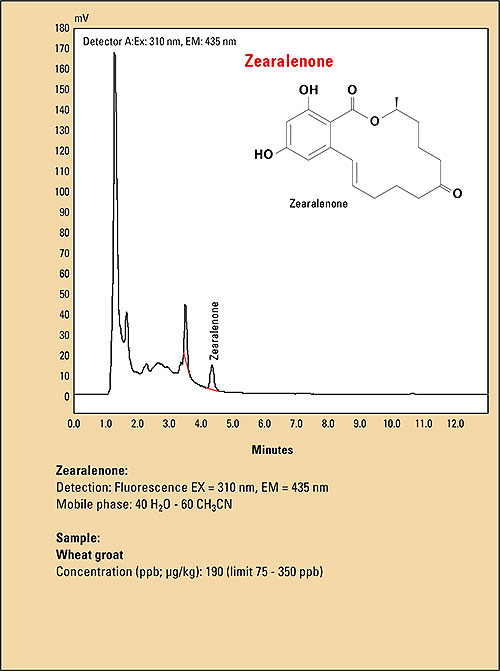Appearances can be deceiving
HPLC Analysis of Mycotoxins
 Figure 1: Chromatogram of aflatoxins in wheat groat
Figure 1: Chromatogram of aflatoxins in wheat groat
Mycotoxins are secondary metabolites of various fungal species. The study of these toxins has become of great importance since many of them contaminate foods, and in some countries endanger the health of human and animal population. Increasing awareness of the hazard posed by fungal toxins in foodstuff and feeds has led to the development of many methods targetting their purification and analysis. In general, mycotoxins are compounds of relatively high molecular weight containing one or more oxygenated alicyclic rings.
The Food and Agriculture Organization of the United Nations (FAO) estimates that up to 25 % of the world’s food production contains mycotoxins. These can even get into the human food chain through livestock products such as milk or eggs. The appearance of assumed excellent food quality can be deceiving. HPLC has become the fastest growing technique available for analytical food laboratories. An isocratic system with C18 column, water, methanol and acetonitrile as mobile phase, and fluorescence and/or UV detection is the typical configuration to detect many toxins (aflotoxins, ochratoxin, zearalenon, funonisins, T-2 and HT-2 etc.) in different matrices (wine, beer, wheat, coffee beans, oats, maize etc).
Experimental
 Common procedure for mycotoxine analysis with HPLC
Common procedure for mycotoxine analysis with HPLC
Apparatus:
The chromatographic equipment consisted of LC-20AD UFLC pump, SIL-20AHT UFLC autoinjector, CTO-20A column oven, RF-20AXS fluorescence detector, CBM-20A, LC solution workstation, Supelco Discovery C18 column 150 mm x 4.6 mm I.D., 5 μm thermostatted at 30 °C, post column reactor Kobra cell (only for aflatoxins).
Reagents:
Water, methanol, acetonitrile, acetic acid, nitric acid, isopropanol, potassium bromide, immunoaffinity columns.
Sample preparation:
Typical sample preparation consists of several simple steps:
- Toxins in a sample are extracted, filtered, diluted and passed slowly through the immunoaffinity column where binding takes place between the antibody and the toxin.
- The immunoaffinity column is then washed to remove any unbound material and the toxins are released from the column using methanol.
- After this injection onto an HPLC system is possible.
 Figure 2: Chromatogram of Ochratoxin A in wheat groat
Figure 2: Chromatogram of Ochratoxin A in wheat groat
 Figure 3: Chromatogram of Zearalenon in wheat groat
Figure 3: Chromatogram of Zearalenon in wheat groat
 Table 1: Overview of analytical methods for mycotoxine analysis
Table 1: Overview of analytical methods for mycotoxine analysis
Conclusion
Methods for the determination of toxins by HPLC have been well developed; separation and determination of toxins in different matrices is no longer difficult. Each toxin can be routinely determined in almost any well-equipped laboratory.
The advent of immunoaffinity columns technology in preliminary clean-up phase has helped in isolation-detection of toxins in many different matrices.